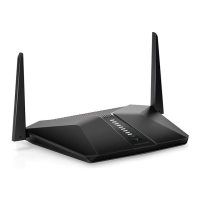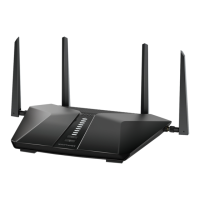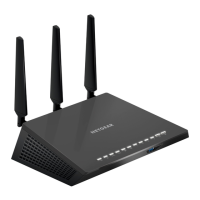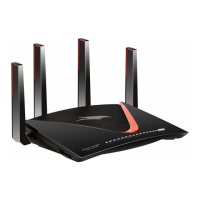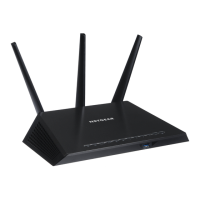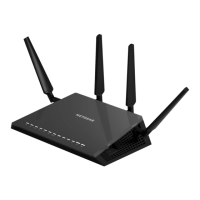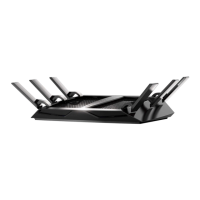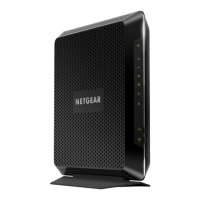Do you have a question about the NETGEAR Nighthawk AXE7300 RAXE290 and is the answer not in the manual?
Details on unpacking the router, power adapter, and Ethernet cable.
Explanation of status LEDs and two buttons on the router's top panel.
Description of the rear panel connectors and buttons on the router.
Details on the information found on the router's label, including login details.
Instructions on extending router antennas and optimal placement guidelines.
Steps to connect the router to your Internet modem and power it on.
Information on how Internet speeds affect port selection and connection.
Instructions and guidelines for mounting the router on a wall.
Guides on connecting to the router via wired, WiFi, or WPS connections.
Explains different login types: ISP, WiFi password, NETGEAR account, and router login.
Instructions for using the Nighthawk app to install and manage the router.
Steps to access and configure the router using a web browser.
Procedure for changing the display language in the router web interface.
Guide to using the Setup Wizard for automatic Internet configuration.
Instructions for manually configuring the router's Internet connection settings.
Configure the router to utilize Multi-Gig ports for high-speed Internet connections.
Steps for configuring IPv6 Internet connections, including auto-detect options.
Guidance on understanding and changing the Maximum Transmission Unit (MTU) size.
Details on managing NETGEAR Armor for network protection and security features.
Configure ACL to block or allow devices based on MAC address.
Learn how to block specific websites using keywords or domain names.
Instructions for removing keywords from the blocked sites list.
Configure rules to block specific Internet services based on type or schedule.
Exempt a specific computer from blocking rules using its IP address.
Set schedules for blocking Internet sites and services.
Configure email alerts for router activity and security events.
Connect devices to your WiFi network using the WPS Wizard with button or PIN.
Configure essential WiFi settings like SSID, channel, and broadcast options.
Adjust WiFi mode settings for 2.4, 5, and 6 GHz bands based on AX WiFi status.
Update the WiFi network password and select security encryption protocols.
Create and configure a separate guest WiFi network with custom security settings.
Set up enterprise-level WiFi security using RADIUS authentication.
Learn how to turn WiFi radios on or off using the button or web interface.
Configure AX WiFi settings to improve network capacity and speeds.
Manage 20/40 MHz channel coexistence for the 2.4 GHz radio.
Configure OFDMA for enhanced WiFi performance, especially with IoT devices.
Adjust the router's WiFi transmission power for coverage and power saving.
Schedule times for the WiFi signal to be turned on or off.
Configure Smart Connect to automatically select the fastest WiFi band for devices.
Configure implicit beamforming to improve WiFi range and performance.
Configure MU-MIMO for improved performance with multiple WiFi clients.
Configure Protected Management Frames (PMF) for enhanced WiFi security.
Configure WPA3 Hash-to-Element for increased WiFi security on compatible clients.
Configure Wide Area Network (WAN) settings, including MTU, DMZ, and port scan protection.
Configure a default DMZ server to improve compatibility with certain online applications.
Customize the router's device name displayed on the network.
Modify the router's Local Area Network (LAN) IP address and subnet mask.
Define the range of IP addresses the router's DHCP server assigns to devices.
Turn off the router's DHCP server feature if another device provides IP addresses.
Assign static IP addresses to specific devices on the LAN for consistent access.
Configure bridges for port groups or VLAN tags, useful for IPTV services.
Define static routes for specific network traffic paths.
Configure the router to function as a WiFi access point in an existing network.
Configure the router in bridge mode to extend WiFi coverage and speeds.
Switch the router back to its default router mode from AP or bridge mode.
Enable Universal Plug and Play (UPnP) for seamless device networking.
Configure flow control for Ethernet ports to manage traffic congestion.
Configure Ethernet port aggregation (link aggregation) for improved speed.
Optimize Internet traffic using Dynamic Quality of Service (QoS).
Understand how WMM QoS prioritizes WiFi voice and video traffic.
Check for and install new firmware versions to keep the router up-to-date.
Secure your router by changing the administrative login password.
Configure password reset options for the router's admin account.
Procedure for resetting the router's admin password if forgotten.
Enforce secure HTTPS connections for accessing the router web interface.
Access information on router status, Internet, and WiFi settings.
View detailed statistics for the router's Internet port, including traffic data.
Verify the status of the router's connection to the Internet.
See a list of all devices currently connected to your network.
Use traffic metering to monitor and control Internet data usage.
Back up, restore, or erase router configuration settings.
Customize LED behavior, including disabling blinking or turning off all LEDs.
Configure the router's time zone and daylight saving time settings.
Configure the router to use a Network Time Protocol (NTP) server for accurate time.
Enable remote access to router settings via the Nighthawk app.
Configure the router as a DLNA media server for sharing media files.
Reset the router to its original factory default configuration.
Details on compatible USB storage devices and file system types supported by the router.
Steps to physically connect a USB storage device to the router's USB port.
How to access connected USB storage devices from a Windows computer.
Instructions for mapping a USB storage device as a network drive in Windows.
How to access connected USB storage devices from a Mac computer.
Configure File Transfer Protocol (FTP) access for network file sharing.
How to view network folders and available storage space on connected devices.
Steps to create new network folders on a USB storage device.
How to modify existing network folder settings on a USB storage device.
Procedure for safely removing a USB storage device from the router to prevent data loss.
Configure Dynamic DNS to access your network remotely using a domain name.
Configure FTP server access through your Dynamic DNS hostname.
Enable secure HTTPS access to your router and connected USB devices.
Learn how to access USB storage devices remotely over the Internet.
Understand Virtual Private Network (VPN) concepts and client-to-gateway tunnels.
Address IP scheme considerations for VPN client connectivity to the router.
Configure and enable the OpenVPN service on the router for VPN connections.
Install OpenVPN client software and configuration files on various devices.
Access your home Internet service remotely using a VPN connection.
Access USB storage devices remotely via a VPN connection to the router.
Configure port forwarding rules to make local servers accessible from the Internet.
Set up dynamic port rules for applications requiring specific port configurations.
Basic steps for resolving common network and router issues.
Diagnose problems by understanding the behavior of router LEDs.
Solutions for issues preventing login to the router's web interface.
Steps to diagnose and fix problems accessing the Internet.
Resolve issues where web pages cannot be loaded despite Internet connectivity.
Troubleshoot why router configuration changes are not being saved.
Diagnose and resolve problems with connecting to the WiFi network.
Use the ping utility to test network paths and diagnose connectivity issues.
Information on returning the router to its original factory default settings.
Detailed technical specifications of the router, including hardware and performance.
Details on unpacking the router, power adapter, and Ethernet cable.
Explanation of status LEDs and two buttons on the router's top panel.
Description of the rear panel connectors and buttons on the router.
Details on the information found on the router's label, including login details.
Instructions on extending router antennas and optimal placement guidelines.
Steps to connect the router to your Internet modem and power it on.
Information on how Internet speeds affect port selection and connection.
Instructions and guidelines for mounting the router on a wall.
Guides on connecting to the router via wired, WiFi, or WPS connections.
Explains different login types: ISP, WiFi password, NETGEAR account, and router login.
Instructions for using the Nighthawk app to install and manage the router.
Steps to access and configure the router using a web browser.
Procedure for changing the display language in the router web interface.
Guide to using the Setup Wizard for automatic Internet configuration.
Instructions for manually configuring the router's Internet connection settings.
Configure the router to utilize Multi-Gig ports for high-speed Internet connections.
Steps for configuring IPv6 Internet connections, including auto-detect options.
Guidance on understanding and changing the Maximum Transmission Unit (MTU) size.
Details on managing NETGEAR Armor for network protection and security features.
Configure ACL to block or allow devices based on MAC address.
Learn how to block specific websites using keywords or domain names.
Instructions for removing keywords from the blocked sites list.
Configure rules to block specific Internet services based on type or schedule.
Exempt a specific computer from blocking rules using its IP address.
Set schedules for blocking Internet sites and services.
Configure email alerts for router activity and security events.
Connect devices to your WiFi network using the WPS Wizard with button or PIN.
Configure essential WiFi settings like SSID, channel, and broadcast options.
Adjust WiFi mode settings for 2.4, 5, and 6 GHz bands based on AX WiFi status.
Update the WiFi network password and select security encryption protocols.
Create and configure a separate guest WiFi network with custom security settings.
Set up enterprise-level WiFi security using RADIUS authentication.
Learn how to turn WiFi radios on or off using the button or web interface.
Configure AX WiFi settings to improve network capacity and speeds.
Manage 20/40 MHz channel coexistence for the 2.4 GHz radio.
Configure OFDMA for enhanced WiFi performance, especially with IoT devices.
Adjust the router's WiFi transmission power for coverage and power saving.
Schedule times for the WiFi signal to be turned on or off.
Configure Smart Connect to automatically select the fastest WiFi band for devices.
Configure implicit beamforming to improve WiFi range and performance.
Configure MU-MIMO for improved performance with multiple WiFi clients.
Configure Protected Management Frames (PMF) for enhanced WiFi security.
Configure WPA3 Hash-to-Element for increased WiFi security on compatible clients.
Configure Wide Area Network (WAN) settings, including MTU, DMZ, and port scan protection.
Configure a default DMZ server to improve compatibility with certain online applications.
Customize the router's device name displayed on the network.
Modify the router's Local Area Network (LAN) IP address and subnet mask.
Define the range of IP addresses the router's DHCP server assigns to devices.
Turn off the router's DHCP server feature if another device provides IP addresses.
Assign static IP addresses to specific devices on the LAN for consistent access.
Configure bridges for port groups or VLAN tags, useful for IPTV services.
Define static routes for specific network traffic paths.
Configure the router to function as a WiFi access point in an existing network.
Configure the router in bridge mode to extend WiFi coverage and speeds.
Switch the router back to its default router mode from AP or bridge mode.
Enable Universal Plug and Play (UPnP) for seamless device networking.
Configure flow control for Ethernet ports to manage traffic congestion.
Configure Ethernet port aggregation (link aggregation) for improved speed.
Optimize Internet traffic using Dynamic Quality of Service (QoS).
Understand how WMM QoS prioritizes WiFi voice and video traffic.
Check for and install new firmware versions to keep the router up-to-date.
Secure your router by changing the administrative login password.
Configure password reset options for the router's admin account.
Procedure for resetting the router's admin password if forgotten.
Enforce secure HTTPS connections for accessing the router web interface.
Access information on router status, Internet, and WiFi settings.
View detailed statistics for the router's Internet port, including traffic data.
Verify the status of the router's connection to the Internet.
See a list of all devices currently connected to your network.
Use traffic metering to monitor and control Internet data usage.
Back up, restore, or erase router configuration settings.
Customize LED behavior, including disabling blinking or turning off all LEDs.
Configure the router's time zone and daylight saving time settings.
Configure the router to use a Network Time Protocol (NTP) server for accurate time.
Enable remote access to router settings via the Nighthawk app.
Configure the router as a DLNA media server for sharing media files.
Reset the router to its original factory default configuration.
Details on compatible USB storage devices and file system types supported by the router.
Steps to physically connect a USB storage device to the router's USB port.
How to access connected USB storage devices from a Windows computer.
Instructions for mapping a USB storage device as a network drive in Windows.
How to access connected USB storage devices from a Mac computer.
Configure File Transfer Protocol (FTP) access for network file sharing.
How to view network folders and available storage space on connected devices.
Steps to create new network folders on a USB storage device.
How to modify existing network folder settings on a USB storage device.
Procedure for safely removing a USB storage device from the router to prevent data loss.
Configure Dynamic DNS to access your network remotely using a domain name.
Configure FTP server access through your Dynamic DNS hostname.
Enable secure HTTPS access to your router and connected USB devices.
Learn how to access USB storage devices remotely over the Internet.
Understand Virtual Private Network (VPN) concepts and client-to-gateway tunnels.
Address IP scheme considerations for VPN client connectivity to the router.
Configure and enable the OpenVPN service on the router for VPN connections.
Install OpenVPN client software and configuration files on various devices.
Access your home Internet service remotely using a VPN connection.
Access USB storage devices remotely via a VPN connection to the router.
Configure port forwarding rules to make local servers accessible from the Internet.
Set up dynamic port rules for applications requiring specific port configurations.
Basic steps for resolving common network and router issues.
Diagnose problems by understanding the behavior of router LEDs.
Solutions for issues preventing login to the router's web interface.
Steps to diagnose and fix problems accessing the Internet.
Resolve issues where web pages cannot be loaded despite Internet connectivity.
Troubleshoot why router configuration changes are not being saved.
Diagnose and resolve problems with connecting to the WiFi network.
Use the ping utility to test network paths and diagnose connectivity issues.
Information on returning the router to its original factory default settings.
Detailed technical specifications of the router, including hardware and performance.
| Model | RAXE290 |
|---|---|
| Wi-Fi Standard | Wi-Fi 6E (802.11ax) |
| Max Wi-Fi Speed | 7.3 Gbps |
| Frequency Bands | Tri-band |
| 5GHz Band | Up to 4.8 Gbps |
| 6GHz Band | Up to 1.9 Gbps |
| Ethernet Ports | 1 x 2.5G WAN, 4 x 1G LAN |
| USB Ports | 1 x USB 3.0 |
| RAM | 512MB |
| Flash Memory | 256MB |
| Security | WPA3 |
| Beamforming | Yes |
| MU-MIMO | Yes |
| OFDMA | Yes |
| Processor | 1.7 GHz quad-core |

